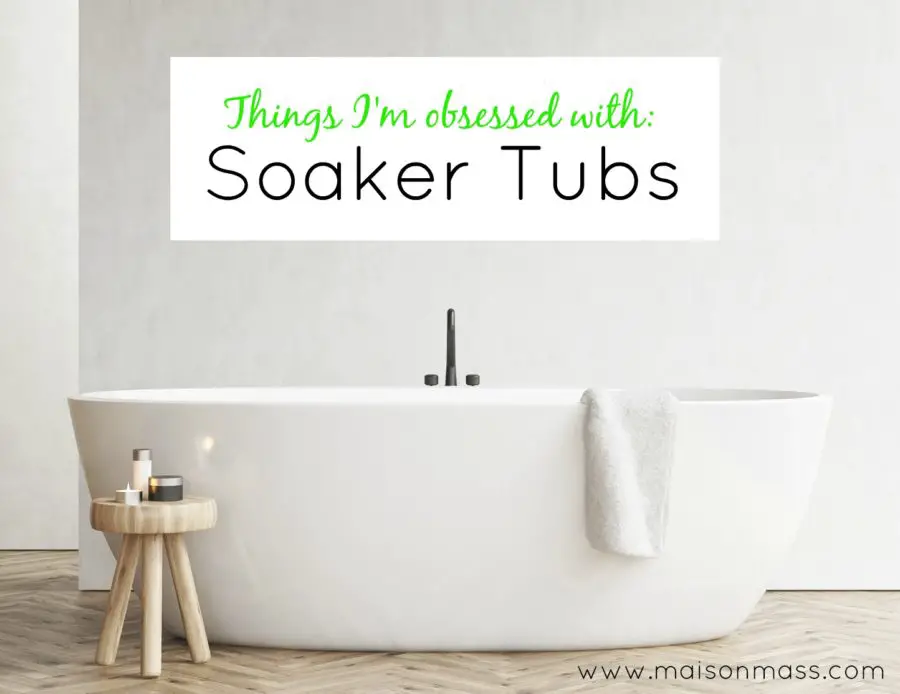Here’s what I am obsessed with right now: soaker tubs.
The backstory
When my husband and I bought our house 15 years ago, we were moving from an apartment in an old house in Newton where time seemed to have stopped in the ‘40s. If you were ever young and renting an apartment in the Northeast, you know what kind of house I am talking about – beautiful bones, but no updating whatsoever. Everything creaked and groaned. The wind blew right through the windows and the pipes knocked together like someone was banging on our bathroom wall every time the toilet was flushed. Every. Single. Time.
So, we were mesmerized by all the “bling” in our new (1989) house. A fridge that was actually located in the kitchen! Washer and dryer! Space! Closets! And a huge master bathroom with a two person jacuzzi-style tub.
When we saw the bathroom for the first time at the open house, we stood by the tub for 20 minutes dreaming what our lives would be like if we just had access to it. Somehow, incredibly, we overlooked the raspberry sherbet colored wall-to-wall carpet in the bathroom (yes, you read that right) and the pink-veined faux marble tile. No, that tub blinded us to all of the bathroom’s sins. The long soaks we would take! The relaxation! Our lives would surely be much fuller and happier with that tub.
All I can say is, that tub let us down. My husband and I joke about it now – all that time we spent marveling over it – because the reality was (and is) we use the tub once or twice a year. That’s it.
There are many reasons why that tub didn’t change our lives:
- It takes forever to fill.
- By the time the water is over the jets, our water heater is only managing a lukewarm stream.
- The water then cools too quickly with the large surface area and the acrylic shell that can’t hold the heat.
- And, with the fixed faucet in one remote corner of the tub, cleaning it afterwards is no mean feat.
So now, as we are planning our new bathroom, I want to avoid the mistakes of the past and (finally!) get my soak on.
The lowdown
These days, the bath industry is turning away from the whirlpool or garden style tubs of the late twentieth century in favor of narrower, deeper soaker tubs. While some of these tubs are still offered in built-in versions, the majority are free-standing works of art. In a sense, it’s a new take on the old-fashioned clawfoot tub. And, the best soakers on the market are taking a page from the past and creating their tubs out of new composite materials that mimic the heat retention properties of cast iron. The cost of these statement pieces can give one pause, so if you are going to make the investment, you want to make sure you do your homework so you don’t end up with bather’s remorse.
Things to consider
-
- Tub material:
-
- Acrylic: for cost and weight considerations, most of the freestanding soaker tubs on the market are acrylic. Acrylic is lightweight, inexpensive and easy to clean. It is also warm to the touch. The downside to an acrylic soaker tub is that it will not retain heat like other materials and can feel a bit unstable when you step into it.
- Gelcoat: this is a fiberglass tub with a gelcoat on top. They are lightweight and strong but the gelcoating is susceptible to fading and cracking.
- Cast iron: A few manufacturers are still making cast iron tubs, mostly in the claw foot style. Cast iron retains heat very well, but is also the heaviest and is at the top end of the price range. Some people don’t like that cast iron can be cold to the touch.
- Engineered stone/composite: engineered stone/composite is another higher end category of material for tubs. Each manufacturer creates their own proprietary formula, but generally it is a mixture of natural stone or recycled materials and resin. Engineered stone/composites retain heat like cast iron but are also warm to the touch.
-
- Tub length: I think the most important dimension is the length of the bottom of the tub. This may seem obvious, since that is where you sit, but often the dimension given on the website or brochure for length is the full length of the longest part of the tub which is most often the top of the tub. So, you may need to dig into the technical specs to uncover the actual length of the bottom. This is important if you are tall or have long legs and want to be able to stretch them out fully in the tub.I found the tubs with some of the biggest curves or angles to be the most beautiful, but they also had, by nature of their designs, the shortest bottom dimensions. So many of the tubs that appealed to me aesthetically, didn’t work for my husband because of their shorter length. Here is where visiting a showroom [see my post on local bath showrooms] is critical. Try out tubs with different bottom dimensions to determine the length you need to be comfortable, then cross any styles off your list that don’t fit the bill.
- Tub material:
-
- Tub width: Besides fitting into your space, you may be wondering what the big deal is with width. We found there are two important aspects of comfort that width affected: heat retention and something I’ll call coziness. In terms of heat retention, several sales people mentioned that the narrower the tub, the faster it will fill and the more the tub will retain the heat once you are bathing (think less surface area of water touching air). The second aspect, coziness is something we felt when trying out the soaker tubs and it is definitely subjective. I found that the narrower the tub, the better I felt. Of course this is a personal preference, but I don’t want to feel like I am sliding around in a big space when I bath – I want to feel cradled and, well, cozy!
-
- The angle and height of the ends: This is the part of the soaker tub where you will be resting your back and in some cases your head. Our experience is that you need to test out what feels best for you. Some soaker tubs are nearly vertical, so you can only really sit upright, others have a steep angle that allows you to recline. The angle does make a difference in how comfortable you feel while lying in the tub. And let’s face it, if you don’t feel comfortable, what’s the point?
So, the key takeaway is, if you plan on actually using your tub, I wouldn’t suggest buying one that you haven’t tested out.
The list*
American Standard – offers a small selection of acrylic freestanding tubs.
Bain Ultra – offers acrylic freestanding baths with light, sound and air features.
DXV – the luxury line of American Standard offering a selection of acrylic freestanding tubs.
Jacuzzi – the eponymous tub maker offers a selection of acrylic freestanding tubs.
Kallista – offers a selection of gelcoat, cast stone and cast iron freestanding tubs.
Kohler – offers a large selection of acrylic freestanding tubs with sound and vibration features.
MTI – offers a very large selection of Engineered Solid-Stone® and cast acrylic freestanding tubs. U.S. brand made in the USA.
Victoria + Albert – offers a large selection of Englishcast® (engineered stone made from volcanic limestone and resin) freestanding tubs. British brand manufactured in South Africa.
WetStyle – offers a large selection of WETMAR BiO™ (engineered material made primarily of soy, mineral stone and resins) freestanding tubs. Canadian brand manufactured in Montreal.
*This list is by no means exhaustive, but it represents the brands we saw on our showroom visits. Full disclosure: we chose a Wetsyle Ove tub for our bathroom remodel.










